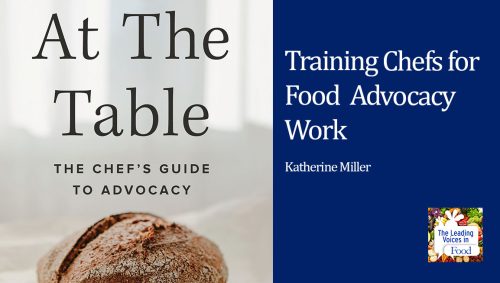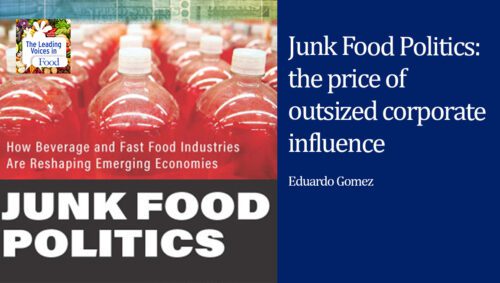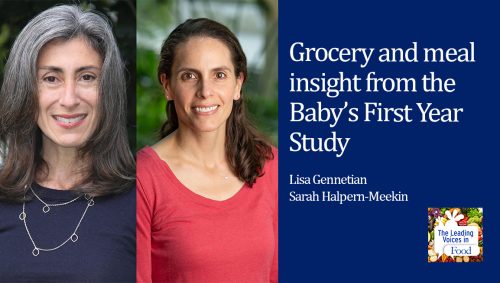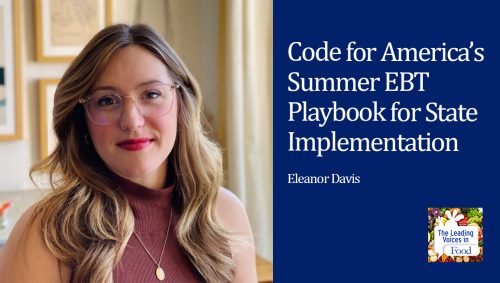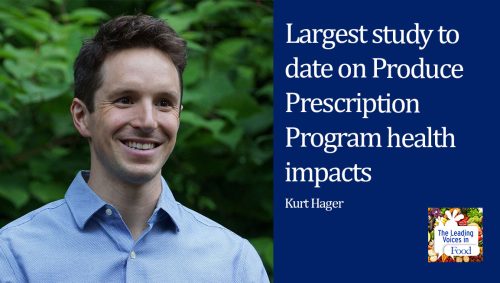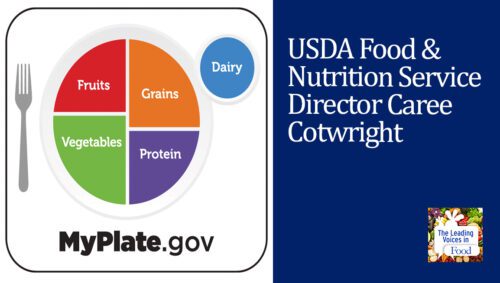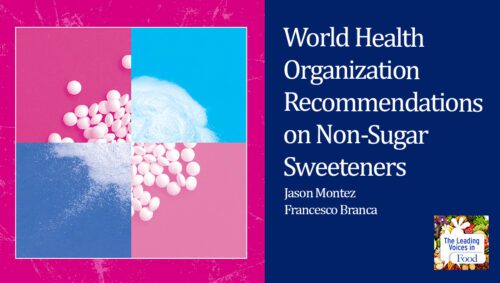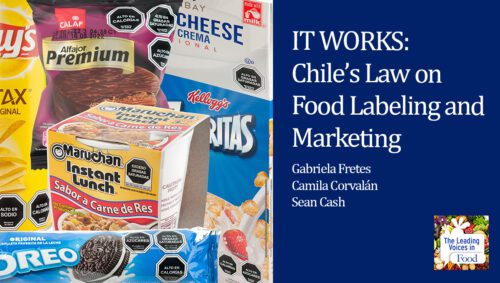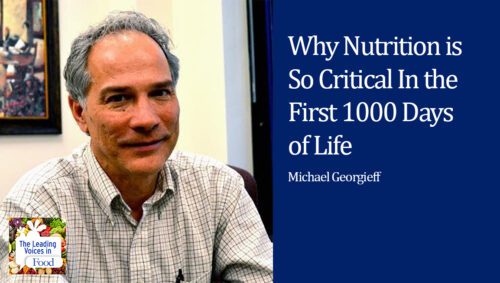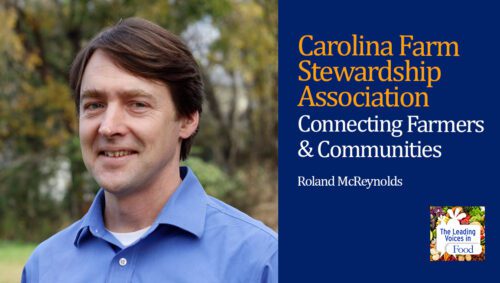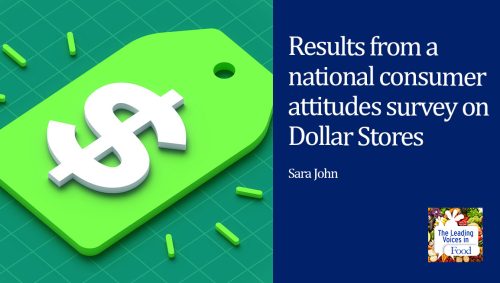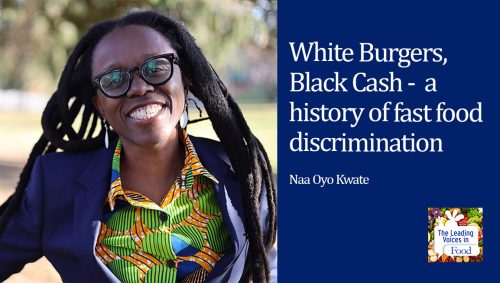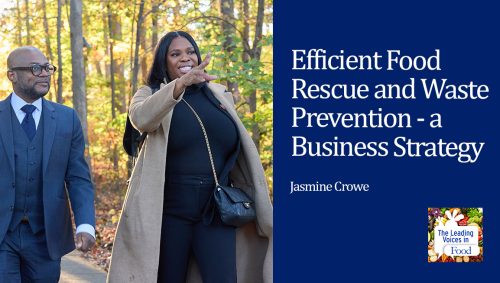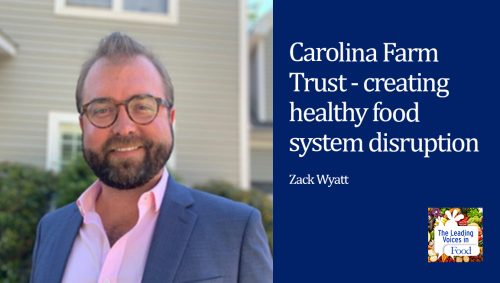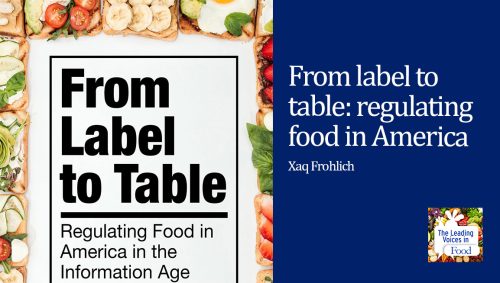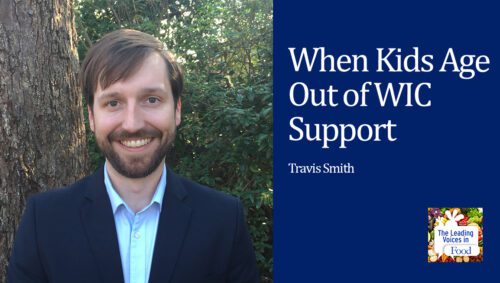The Leading Voices in Food
E77: School Meals During a Pandemic – What Works with Katie Wilson
About 33 million children access school meals every day across the country. Today, we’re exploring the impact of the COVID-19 pandemic on young students: children who receive much needed nutrition through their school. We interviewed Dr. Katie Wilson, executive director of the Urban School Food Alliance. The Urban School Food Alliance is a nonprofit coalition of the largest school districts in the U.S, including New York, LA, Chicago, Dallas, Philadelphia, Baltimore and Boston.
Subscribe: Apple Podcasts | TuneIN | Google Podcasts | SoundCloud | PocketCasts | Radio Public
Tags: Advocacy & Food | Child Development & Nutrition | Childhood Obesity | Children Food Preferences | COVID-19 Pandemic Impacts on Food | Diet & Nutrition | Equity, Race & Food Justice | Food Insecurity | Food Policy | School Meals |

Dr. Katie Wilson has dedicated her career to improving access to healthy food for all children and families. She spent 23 years as a successful school nutrition director in three Wisconsin public schools, and five years as Executive Director for the Institute of Child Nutrition (USDA’s training portal for school nutrition nationwide) and University of Mississippi assistant professor. She also served two years as US Department of Agriculture Deputy Under Secretary of Food, Nutrition, and Consumer Services, appointed by President Obama. She is now the executive director for the Urban School Food Alliance. Wilson holds a BS degree in dietetics, a master’s degree in food science and nutrition and a doctorate in foodservice and lodging management. She is credentialed as a School Nutrition Specialist.
Interview Transcript
Can we begin by asking you to help us understand the role that school meals play in reducing food insecurity for children and why is this help needed?
Sure, school meals are really the best safety net this country has to offer when it comes to food insecurity for children because when you think about it, a child walks through the school cafeteria door and they receive food. There is no way anyone can take that away, or use it for another purpose. So, the child is really well nourished. We follow a very strict nutrition guideline, so that child is getting a very balanced nourished meal. About 33 million children access school meals every day across the country. 22 million of those children qualify for meal benefits. So in other words, they live below the poverty line, and in many cases, this may be the only place they actually get nourishment.
How important is that nourishment for the development of the child, resisting health challenges and things like that?
We know very clearly that the science shows that a well-nourished child does much better in the classroom. It also gives the child a well-being, and we know that good nourishment for younger children also increases the likelihood for them to have a well life as they get older. It also teaches children a lifelong skill. How do you choose a well-balanced meal? As they grow older and leave our custody of schools, they then begin to make better choices for themselves as well. I think all around, this is really a wonderful program for children as they go through the school system.
So, many of the nation’s largest school districts like New York, LA, Chicago, Dallas, Philadelphia, Baltimore or Boston and others are part of the Urban School Food Alliance and you mentioned 33 million meals being served to children, what happened when COVID hit?
Well, when COVID-19 hit, schools of course closed, and so did those school cafeterias, and the opportunity for those children to get that nourishment that is so critical for their daily functioning and their daily lives. The school districts do not have to serve food when school is closed. It is a choice if a school district does this. As far as the Urban School Food Alliance districts are concerned, and many other districts across the country, they quickly changed to a different distribution model. They had to change their menus, go to a grab-and-go, went curbside, went into a pattern of doing a distribution of only once a week so that they would reduce the contact time, and make sure that both staff and families were being protected as well. It became a very quick literally overnight switch to make sure that families and children were getting access to good food.
You mentioned that the school systems that are part of the Urban School Food Alliance went into action quickly and did what they could to be resilient and help feed children. Is this common do you think in schools around the country in general that the school systems have kicked into gear and tried to be helpful in providing food to children?
I think it is pretty common. I think you’ll find out that school nutrition professionals really feel that these children need them. I think even though they were putting their own health at risk to do this and to serve these meals. There really was no protective equipment given to any school nutrition professionals. Many of them still are using homemade equipment, but if you ask any of them across the country, “Why are you doing this? Why are you coming in to serve children?” Their answer to you is going to be, “Where else will these kids get food “if it’s not through us?” Many districts across the country decided that they are the food hub for their community, they take care of their community, and so that was just a natural thing to do even though it’s become financially very difficult for them to continue.
So, Katie, what is working well right now from your perspective?
Well, right now, I think one of the best things that is working is weekly distribution. They are putting food together for an entire week per child and more people are coming to the sites to get that distribution of food. I think it is because they feel safer, there’s less contact time. They can share that food really and truly within the entire family and the entire household. The other thing I think that is working really well are the municipalities that have partnered with food banks. The food banks, many times will come and hand out additional food to families for other people in the household, or to make sure they make it through the weekend. Those two things work really well.
Katie, you have an interesting perspective on this, not only because of your current position, but formally having served as a deputy Under Secretary of Food, Nutrition, and Consumer Services at USDA, I’m particularly interested in your perspective on this next question. So, what do you think is not working well now and are there weaknesses in our food system, particularly school foods that need to be recognized and addressed?
Yeah, I think there are a lot of weaknesses that have really come to light in this pandemic, and it’s too bad it took a crisis but it did. One of the things that is really not working is the fact that school meals are a per meal reimbursement program. If you can imagine serving 500 to 600,000 meals in a day, but you have to identify which ones are breakfast, which ones are lunch, what components go into each one of those meals, which ones might be dinner, and which components go into that meal, and then how many students you are serving. So, a per meal reimbursement model is not an emergency feeding model and it really does not work. It is very labor intensive. A lot of packaging material is going into all these individual meals.
Really, what we need and we always needed was a national emergency community feeding plan, and had there been something like that, we have the kitchens, we have institutional kitchens that can serve large quantities of people. We have coolers and freezers full of food, and most of it belongs to the USDA. We have the staff, a skilled staff that can prepare the food. We needed a new model where we could have given out more bulk and being reimbursed back for labor, food, and supplies that were used, rather than all this individual stuff and then having to claim everything individually.
The other piece that is really missing in an emergency feeding model is that adults come and are asking for food. Every school district I know is giving adults food if they ask for it but they know full well there’s no way to get reimbursed for that meal, and yet they’re doing it anyway because again, they feel so committed to their communities. In an emergency community-feeding model, we would have had a plan so that families could get food, not just individual students.
Oh, there are so many heroes out there, aren’t there?
Yes, there definitely are. They really are doing heroic work, and yet they just feel so passionate about it, they feel compelled to keep going.
So, Katie, as you think about broadening the safety net for even more children, and building more resilience into the system, what sort of policy changes do you think might be helpful?
I think we need to think about a couple of things, and we have been talking about these for literally decades. One of them is universal free meals. We have talked about this for so long in the United States. We absolutely have the money, we have the food supply, we just need the will.
What universal free meals would do is first of all, every child that walks through that door would get meals at school. It is an integral part of the school day. Then, school meals would also raise its level of importance so that we would have time to eat. We would get rid of all the stigma there is to children coming to the cafeteria to receive meals. Again, we know that the scientific evidence is there that they do better in the classroom when they are well nourished. The National School Lunch Program started because young men coming out of the depression were not nourished well enough to be in the draft, and so it was really a matter of national security, and I think we are back there again. We have to have the will in this country to take care of young people as they come through our school systems.
We also need to think about how are we going to do this in the sense of an emergency. We should have some emergency feeding plans in place. We do fairly well when there is a natural disaster for small groups of populations, and small areas of the country, where we literally transfer food to other areas so that they have the food they need. But now obviously, we’ve seen very clearly that there needs to be a national plan, and that should be built in policy so that we know what to do, how to do it, and when to do it in situations like this.


